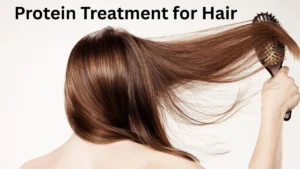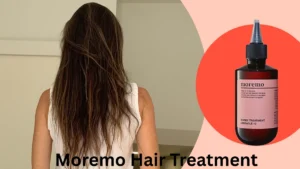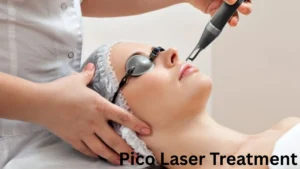Protein Treatment for Hair: If you believe that lengthy hair care treatments are expensive or unnecessary, you might be missing out on the best your hair deserves. Among the popular hair care options, protein treatments for hair have become a favorite for many due to their affordability and multiple benefits. Whether your hair is curly, straight, or somewhere in between, protein treatments can help restore its health, shine, and strength.
In this guide, we’ll cover everything you need to know about protein treatments—from what they are, their benefits, when you need them, and how to get the best results.
| Aspect | Details |
|---|---|
| Main Protein Involved | Keratin, an essential structural protein in hair. |
| Purpose | Repair protein loss, reduce damage, improve hair strength, shine, and manageability. |
| Common Types | Keratin Treatment, Cysteine Treatment, Formaldehyde-free treatments, At-home protein masks. |
| Benefits | – Adds shine and softness – Strengthens hair strands – Repairs heat and chemical damage – Reduces breakage and hair fall – Improves thickness and volume |
| Signs You Need Treatment | – Hair loses elasticity – Excessive breakage – Rough or stringy texture – High porosity – Color-damaged hair |
| Frequency | Salon treatments: Every 4-6 months At-home masks: Every 1-2 weeks |
| How to Apply at Home | Apply protein mask on damp hair, leave 15-30 minutes, rinse with cool water, follow with moisturizer. |
| Precautions | Avoid overuse to prevent stiffness; choose formaldehyde-free products; consult professional for salon treatments. |
| Suitability | Suitable for all hair types but should be personalized based on hair condition. |
What Is Protein Treatment for Hair?
Protein treatment is a hair care procedure designed to replenish the natural proteins in your hair strands, primarily keratin—the key structural protein that makes hair strong and resilient. Over time, hair loses protein due to damage caused by heat styling, chemical treatments, and environmental factors. Protein treatments help restore these lost proteins, repairing and strengthening the hair from within.
What Is Hair Protein Made Of?
Hair strands are made up of keratin, a fibrous protein formed by amino acids. This keratin framework provides strength, elasticity, and structure to your hair. When protein levels are sufficient, hair looks smooth, shiny, and healthy. But when protein is depleted, hair becomes weak, brittle, and prone to damage.
Why Do Hair Lose Protein?
Protein loss in hair happens due to heat styling, chemical treatments, environmental exposure, and physical damage. Frequent use of straighteners, curling irons, and blow dryers breaks down keratin bonds. Coloring, bleaching, and perming damage the hair’s protein structure. Sunlight, pollution, and harsh weather strip away natural proteins. Rough brushing and over-washing weaken hair protein. When protein is lost, hair appears dull, frizzy, and more susceptible to breakage and split ends.
Types of Protein Treatments for Hair
Salon-based treatments include Keratin Treatment, which uses keratin proteins to smooth and strengthen hair, often sealed with heat; Cysteine Treatment, a gentler alternative that strengthens hair bonds without harsh chemicals; and Formaldehyde-Free Treatments, safer options without harmful chemicals for healthy results.
At-home treatments involve protein hair masks and conditioners that help replenish proteins gradually. Natural protein sources like eggs, yogurt, and avocado can also provide nourishment.
Read more: Hair Transplant Abu Dhabi: Restore Your Confidence with Natural-Looking Results
Benefits of Protein Treatments
Protein treatments strengthen hair by repairing damage and reinforcing hair strands from within. They add gloss and reduce frizz for a silky texture and nourish hair layers, giving more volume. Protein treatments also reduce hair fall by strengthening hair to minimize breakage and improve manageability, making hair easier to style and maintain.
How to Know If You Need a Protein Treatment
Look for signs such as loss of elasticity where hair doesn’t bounce back when stretched, excessive breakage beyond the normal 50-100 strands daily, rough or stringy texture, high porosity where hair strands sink quickly in water indicating gaps and damage, and color damage resulting in faded or brittle hair after dyeing.
Read more: Top 7 Benefits of Moremo Hair Treatment: The Ultimate Guide to Transforming Damaged Hair
How Often Should You Get Protein Treatments?
It’s best to get protein treatments every 4 to 6 months at the salon. Overdoing protein treatments can lead to protein overload, causing stiffness and dryness. For at-home protein masks, once every 1-2 weeks is ideal to maintain balance without overloading.
How to Do a Protein Treatment at Home
Start with clean, damp hair. Apply a protein-rich mask evenly from roots to tips. Leave it on for the recommended time (usually 15-30 minutes). Rinse thoroughly with cool water. Follow with a moisturizing conditioner to balance hydration. Avoid heat styling immediately after to prevent damage.
Combining Protein Treatments with Other Hair Care Practices
For healthy hair, balance protein treatments with moisturizing products. Hair needs both protein and moisture to stay flexible and strong. Use gentle shampoos, avoid excessive heat, and protect hair from UV rays and pollution for best results.
Potential Side Effects and Precautions
Avoid protein treatments if you have sensitive scalp or allergies. Choose formaldehyde-free products to prevent harmful effects. Always consult a professional stylist for salon treatments to avoid heat damage. Overuse of protein treatments can cause hair to become brittle, so monitor your hair’s response.
Frequently Asked Questions (FAQs)
Q: Can protein treatments damage hair?
A: When used correctly and in moderation, protein treatments strengthen hair. Overuse, however, can cause stiffness and dryness.
Q: How long do protein treatments last?
A: Salon protein treatments can last 3-6 months. At-home treatments provide gradual benefits with regular use.
Q: Are protein treatments suitable for all hair types?
A: Yes, protein treatments benefit all hair types but should be tailored based on individual hair needs.
Q: Can I combine protein treatments with coloring?
A: Yes, protein treatments can help repair and protect hair from coloring damage. Avoid simultaneous application to prevent overload.
Conclusion
Protein treatments are an essential part of a healthy hair care routine, helping repair damage, restore strength, and enhance shine. Whether you choose a salon treatment or an at-home protein mask, incorporating protein into your hair care regimen can transform dull, brittle hair into smooth, resilient locks. Remember to balance protein with moisture and avoid overuse for the best results.





